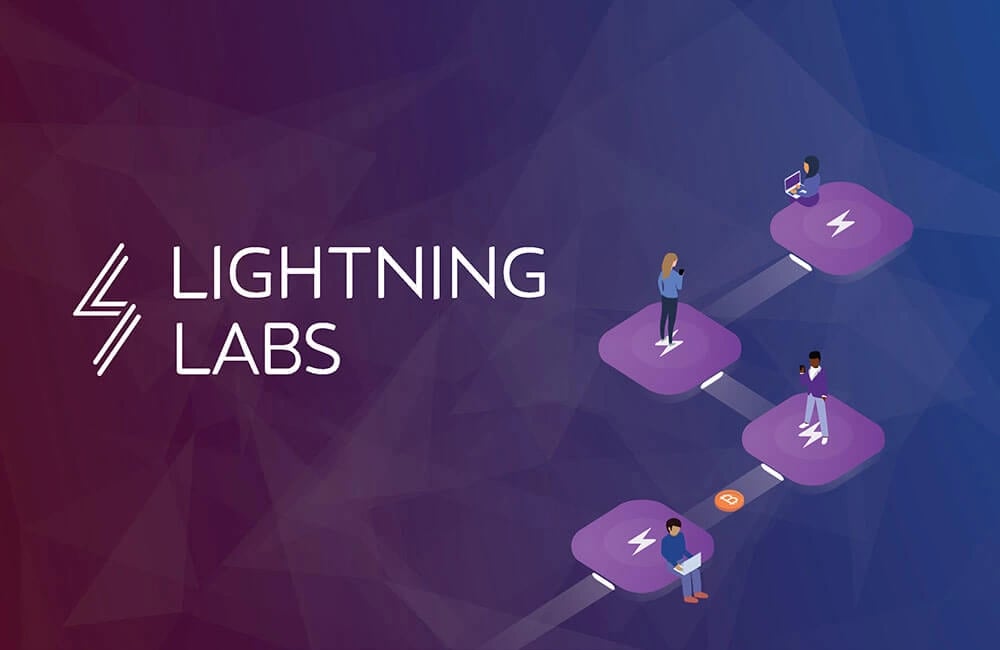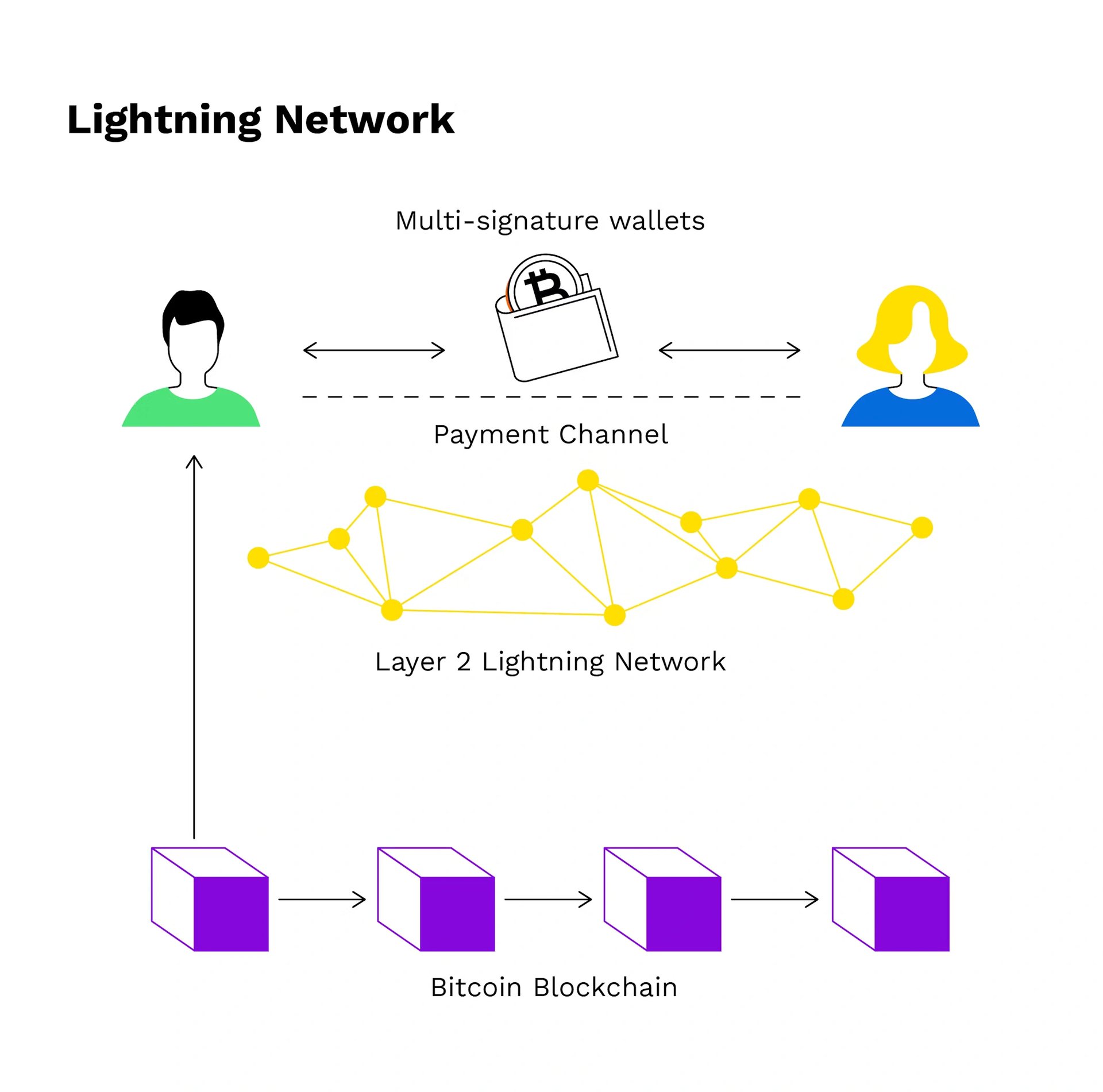위키 구독하기
Share wiki
Bookmark
Lightning Network
Lightning Network
라이트닝 네트워크(Lightning Network)는 2계층 솔루션으로, 오프체인 결제 채널을 허용하여 비트코인 블록체인에서 더 빠르고 저렴한 거래를 가능하게 하도록 설계되었습니다. 이 분산형 네트워크는 즉각적인 마이크로페이먼트를 가능하게 하고 비트코인의 확장성을 향상시켜 일상적인 사용에 더 적합하게 만듭니다. [1][2]
개요
라이트닝 네트워크는 피어투피어 결제 시스템으로, 블록체인 상의 결제 채널을 연결하여 빠르고 저렴한 비트코인 거래를 가능하게 합니다. 이러한 채널들은 연결되어 있어 참여자 간의 신뢰 없이 네트워크 전체에서 결제가 가능합니다. 거래에는 송신자의 노드에서 수신자로의 경로가 필요하며, 각 노드의 유동성 가용성에 대한 가시성이 제한되어 여러 번의 시도가 필요할 수 있습니다. 결제는 원자적이며, 노드가 응답하지 않더라도 완료 또는 실패를 보장하기 위해 해시 타임락 계약(HTLC)을 사용합니다. 라우팅 노드는 전략적으로 유동성을 관리하여 안정적인 거래를 지원함으로써 수수료를 얻습니다. [2][3]
Lightning Labs

엘리자베스 스타크 (Elizabeth Stark)와 Olaoluwa Osuntokun이 설립한 Lightning Labs는 빠르고 저렴하며 전 세계적으로 접근 가능한 2계층 비트코인 거래를 가능하게 하는 Lightning Network를 구동하는 소프트웨어를 개발합니다. 그들의 오픈소스 기반의 안전하고 확장 가능한 Lightning 시스템은 송금 및 수신을 간소화합니다. 또한 Lightning Labs는 Lightning Network에서 검증 가능하고 비보관식 금융 서비스를 제공하여 오픈소스 기술과 차세대 비트코인 기반 금융 소프트웨어를 연결합니다. [1]
특징
라이트닝 루프 (Lightning Loop)
라이트닝 루프는 사용자가 온체인 비트코인 주소와의 거래를 용이하게 함으로써 라이트닝 채널 유동성을 관리할 수 있도록 합니다. 루프 아웃(Loop Out)은 라이트닝 거래를 온체인 주소로 보내 인바운드 용량을 생성하는 반면, 루프 인(Loop In)은 온체인 비트코인을 라이트닝 채널로 보내 아웃바운드 유동성을 추가합니다. 신뢰 없는 서브마린 스왑을 사용하는 루프는 비보관 방식으로 작동하여 안전하고 독립적인 거래를 가능하게 합니다. 루프 아웃 거래는 수수료를 최소화하기 위해 배치됩니다. 루프 서비스의 인증에는 Macaroons와 라이트닝 결제 확인을 결합하여 접근 권한을 보호하는 L402가 사용됩니다. [4]
라이트닝 풀
라이트닝 풀은 라이트닝 채널 유동성(LCL)을 임대하기 위한 비보관 경매 플랫폼입니다. 참가자는 만기일이 비트코인 계약을 통해 보장되는 시간 제한 자산으로 유동성을 사거나 팔 수 있습니다. 이러한 임대를 통해 참가자는 인바운드 또는 아웃바운드 유동성을 확보하고 이자를 벌 수 있습니다. 비트코인 계약으로 집행되므로 제작자의 자금은 만기까지 잠겨 있습니다. [3]
처리된 주문은 일괄 온체인 트랜잭션으로 처리되어 라우팅 수수료 외에도 참가자에게 안정적인 수입원을 제공합니다. 공개 경매 형식을 통해 시장은 유동성이 가장 필요한 곳을 알려주어 유휴 채널을 줄이고 유동성 분배를 최적화합니다. 풀은 참가자가 필요한 비율로 인바운드 자금을 확보할 수 있도록 하여 유동성 수요에 따라 시장 주도 가격 책정을 통해 신규 참가자를 지원합니다. [3]
지불 채널
라이트닝 네트워크는 각각 두 피어 간의 2-of-2 다중 서명 계약을 나타내는 지불 채널로 구성되며, 여기서 반복적인 비트코인 거래를 할 수 있습니다. 커밋먼트 트랜잭션은 채널의 각 트랜잭션 업데이트를 기록하며, 어느 한 당사자도 최신 트랜잭션을 사용하여 채널을 일방적으로 닫고 다른 당사자의 동의 없이 온체인으로 자금을 회수할 수 있습니다. 이 과정을 강제 종료라고 합니다. 이 프로토콜은 (더 높은 잔액을 얻기 위해 오래된 커밋먼트 트랜잭션을 게시하여) 위반을 방지하기 위해 페널티 시스템을 사용하며, 악의적으로 행동하는 당사자의 자금은 페널티를 받습니다. [5][6]
감시탑(Watchtowers), 별도의 네트워크 노드는 비트코인 블록체인에서 특정 트랜잭션 ID를 감시하여 위반을 감지합니다. 감시탑은 위반을 감시하지만 커밋먼트 세부 정보를 볼 수 없으므로 사용자 개인 정보가 보호됩니다. 위반을 감지하면 감시탑은 복호화하여 취소 트랜잭션을 게시하여 페널티를 부과하고 공격자가 자금에 접근하지 못하도록 하며 채널 잔액을 몰수하여 처벌합니다. [5][6]

가십 네트워크
라이트닝 네트워크는 노드들이 자신에 대한 정보(공개 채널, 라우팅 수수료, 네트워크 접근 세부 정보 포함)를 공유하기 위해 가십 네트워크를 사용합니다. 각 노드는 이 공유 데이터를 기반으로 네트워크 그래프를 구성하여 트랜잭션 경로를 결정하지만, 일부 라우팅 노드는 이러한 요구 사항을 무시할 수 있습니다. 노드의 빈번한 수수료 업데이트로 인해 종종 바쁜 가십 네트워크는 네트워크 그래프에 대한 엄격한 합의가 없습니다. 노드는 비활성 피어를 제거하거나 특정 업데이트를 놓칠 수 있습니다. 그래프 데이터를 통해 노드는 총 노드 수, 채널 수, 그리고 각 노드의 중앙성(경로가 얼마나 자주 통과하는지를 나타내는 척도)을 포함한 네트워크 메트릭을 분석할 수 있습니다. 하지만 중앙성이 반드시 최적의 라우팅 수수료를 의미하는 것은 아닙니다. 스팸을 방지하기 위해 노드는 적어도 하나의 공개 채널을 가진 노드의 가십 메시지만 중계합니다. 이는 비트코인 스테이크와 트랜잭션 수수료를 통한 참여를 보장하기 위함입니다. [7]
경로 탐색
라이트닝 네트워크에서 지불자는 지불 경로를 선택하며, 직접적이고 저렴한 경로를 목표로 하지만 종종 수수료가 다른 여러 경로를 시도해야 합니다. 노드는 경로 탐색을 최적화하기 위해 다양한 전략을 사용할 수 있으며, 일부는 이 프로세스를 아웃소싱할 수 있습니다. 각 경로는 어니언 암호화되므로, 발신자만 전체 경로를 알고, 중간 노드는 이전 및 다음 채널만 보고, 수신자는 지불의 출처를 알지 못하고 최종 홉만 알게 됩니다. [8]
라이트닝 프로토콜 (L402)
L402는 이전 명칭이 LSAT이었던 프로토콜로, 라이트닝 결제와 마카룬 기반 인증을 결합하여 분산 네트워크에서 안전하고 효율적인 유료 API 접근을 가능하게 합니다. 이 프로토콜을 구현하는 Aperture는 gRPC 및 REST에 대한 역방향 HTTP 프록시 역할을 하여 유료 API가 결제, 권한 부여 및 요청 처리를 분리할 수 있도록 합니다. 비보관 스왑 및 채널 유동성을 위한 서비스인 라이트닝 루프 및 풀은 현재 이러한 프로세스를 처리하기 위해 Aperture를 사용합니다. L402는 라이트닝 API 키로, 마카룬과 결제 해시를 결합하여 중앙 사용자 데이터베이스 없이 분산 시스템에서 인증 및 검증을 용이하게 합니다. L402가 유효하려면 결제 해시와 라이트닝 인보이스 결제를 통해 얻은 프리이미지를 포함하는 마카룬이 필요합니다. 이를 통해 기존 로그인 방법 없이 미터링된 기기 간 API 접근이 가능하며, API 요청에 대한 결제 및 권한 검증이 가능합니다. [9][10]
마카룬 (Macaroons)
마카룬은 분산 시스템에서 안전한 인증을 위해 설계된 베어러 토큰입니다. 권한을 포함하며 루트 키만 사용하여 검증할 수 있으므로 중앙 데이터베이스 조회가 필요 없어 시스템 복원력과 효율성이 향상됩니다. 쿠키와 달리 마카룬은 제한하고 안전하게 위임할 수 있으므로 사용자가 권한을 제어할 수 있습니다. 그러나 루트 키를 삭제해야 모든 관련 토큰이 무효화되므로 취소하기가 어렵습니다. [11]
Taproot 자산
Taproot 자산은 비트코인(Bitcoin)의 Taproot 업그레이드를 활용하는 프로토콜로, 비트코인 블록체인에서 자산 발행을 가능하게 합니다. 이는 라이트닝 네트워크를 통해 빠르고, 대량이며, 저렴한 거래를 가능하게 합니다. Taproot의 고급 트리 구조와 Schnorr 서명을 활용하여 Taproot 자산은 개인 정보 보호 및 확장성을 향상시키고, 멀티 홉 거래 및 광범위한 라이트닝 네트워크와의 통합을 지원합니다. 검증 비용은 참여자가 자산 데이터를 로컬 "유니버스(Universes)" 저장소에 오프체인으로 저장하고 생성 이후의 거래 내역을 추적하여 전용 가십 계층을 통해 검증함으로써 분산됩니다. [12][13]
에지 노드(Edge Nodes)
에지 노드는 Taproot Assets를 인식하는 특수한 라이트닝 노드로, Taproot Assets와 비트코인 채널 간의 거래를 용이하게 합니다. 서비스 제공자 역할을 하는 에지 노드는 클라이언트와 개인 Taproot Assets 채널을 유지 관리하는 동시에 공개 라이트닝 네트워크에 연결되어 있습니다. 에지 노드를 통해 Taproot Assets 지갑은 자산 간 비트코인 스왑을 지원하여 표준 라이트닝 서비스와 원활하게 상호 작용할 수 있으며, 모든 라이트닝 인보이스로 결제할 수 있습니다. 클라이언트는 Taproot에서 비트코인으로의 변환에 대한 실시간 견적을 받을 수 있으며, 에지 노드는 결제의 원자적 라우팅을 통해 수수료를 벌어들입니다. 에지 노드는 환율 변동성을 완화하기 위해 포지션을 헤지하여 다양한 자산 유형에 걸쳐 안정적인 스왑을 제공할 수 있습니다. [14]
라이트닝 터미널 (Lightning Terminal)
라이트닝 터미널은 라이트닝 랩스(Lightning Labs) 제품을 관리하기 위한 웹 기반 대시보드로, 원격 인터페이스를 통해 노드 관찰, 채널 관리 및 유동성 솔루션을 제공합니다. 라이트닝 노드 커넥트(LNC, Lightning Node Connect)로 보안되어 모든 노드 데이터가 라이트닝 랩스로부터 비공개로 유지되는 엔드투엔드 암호화 연결을 보장합니다. 사용자는 노드 순위, 중앙성 및 성능 통계를 확인하고 라이트닝 루프(Lightning Loop)를 활용하여 채널 유동성을 관리하여 자금을 온체인 또는 라이트닝 채널로 이동할 수 있습니다. 라이트닝 풀(Lightning Pool)을 사용하여 사용자는 채널 유동성을 사고 팔고, 주문을 추적하고 채널을 모니터링할 수 있습니다. 또한 터미널은 Taproot Assets 통합을 지원하여 라이트닝 네트워크를 통한 자산 전송을 가능하게 합니다. 터미널은 브라우저를 통해 접근할 수 있지만, 자체 호스팅 설정(litd)의 경우 웹 기반 권장 사항, 결제 기능 및 거래 추적 기능이 부족합니다. [15]
라이트닝 노드 커넥트
라이트닝 노드 커넥트(LNC)는 Tor 또는 NAT 뒤에 있더라도 라이트닝 노드에 대한 안전하고 종단 간 암호화된 연결을 가능하게 하여 원격 노드 관리를 간소화합니다. 라이트닝 터미널은 이 오픈소스 도구를 사용하여 브라우저나 앱을 통해 노드에 애플리케이션을 연결합니다. LNC는 LND의 gRPC 인터페이스에 의존하며, 노드는 사용자 액세스를 위해 웹 프록시에 아웃바운드 연결을 생성합니다. 암호로 인증된 키 교환(PAKE)은 사용자와 노드 간의 암호화된 세션을 보장합니다. [16]
LNC 시스템은 세 가지 주요 구성 요소로 이루어져 있습니다. [16]
- 라이트닝 노드 커넥트는 라이트닝 터미널 데몬(litd)에서 실행되며, 요청, 데이터 전송 및 인증을 위한 마카룬을 처리합니다.
- **프록시(TURN)**는 NAT 또는 방화벽 뒤에 있는 노드에 대한 네트워크 트래버설을 지원하여 동기식 통신 채널을 생성합니다.
- 애플리케이션 (예: 라이트닝 터미널)은 웹 서버를 통해 액세스하며, 다양한 기기에서 독립적으로 사용될 수 있습니다.
LNC는 브라우저 확장 프로그램, 모바일 지갑 및 네트워크 익스플로러가 노드에 연결하고 관리하며, 결제를 보내는 등의 작업을 지원합니다. [16]
파트너십
- 바이낸스 (Binance)
- 코인베이스 (Coinbase)
- 심플스왑 (SimpleSwap)
- 크라켄 (Kraken)
- 빗파이넥스 (Bitfinex)
- 빗썸 (Bithumb)
- 빗스탬프 (Bitstamp)
- 쿠코인 (Kucoin)
- OKEx
- OKCoin (OKCoin)
- 나이스해시 (NiceHash)
- 코인코너 (CoinCorner)
- 빗맥스 (BitMex)
- 부다 (Buda)
- 스트라이크 (Strike)
- 마운트 펠레린 (Mt Pelerin)
- 팍스풀 (Paxful)
- 불비트코인 (BullBitcoin)
- 비타루 (Bitaroo)
- 리버 파이낸셜 (River Financial)
- VBTC 베트남 (VBTC Vietnam)
- 픽스드플롯 (FixedFloat)
- 로프트 (LOFT)
- 프라임빗 (PrimeBit)
- 심플FX (SimpleFX)
- 비트코인VN (BitcoinVN)
- 비파 (Bipa)
- 볼츠 (Boltz)
- 콜리더 (Kollider)
- LN 마켓츠 (LN Markets)
- 타우로스 (Tauros)
- 코인피니티 (Coinfinity)
- 리피오 (Ripio)
- 스텔스EX (StealthEX)
- 시큐어쉬프트 (SecureShift)
- 라이노 비트코인 (Rhino Bitcoin)
잘못된 내용이 있나요?
